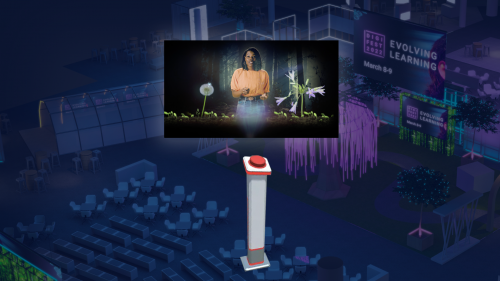Gooii Portfolio: AR Exhibition for Jisc’s (e)co Garden
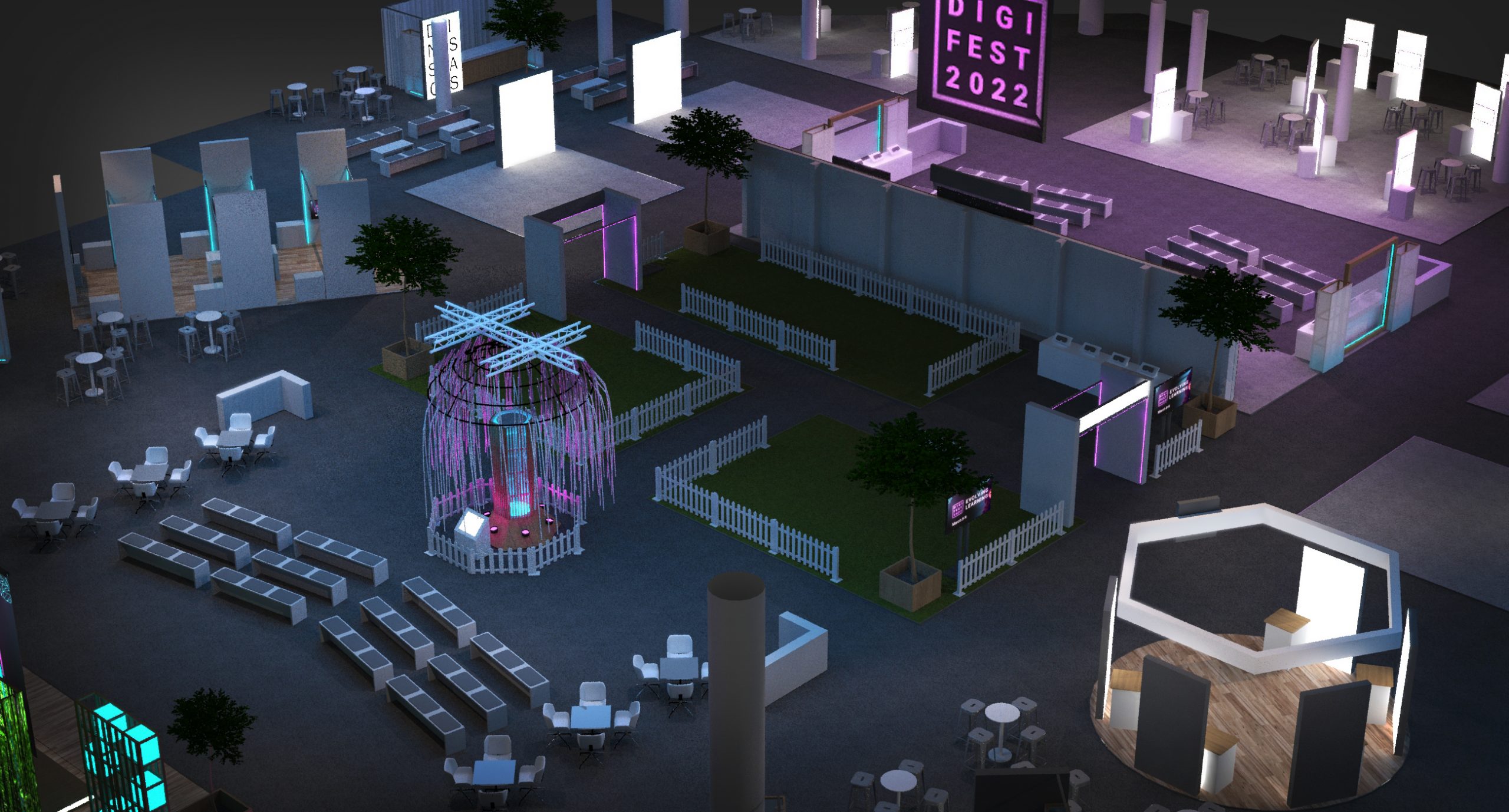
Creating a virtual AR garden to engage with delegates on digital sustainability
An Augmented Reality exhibition that appears before your very eyes
Jisc’s (e)co garden was a collaborative Augmented Reality (AR) learning experience. By putting on AR headsets, visitors were able to cultivate a virtual garden that appears in a real-world exhibition space at Digifest, Jisc’s flagship event for education, research and innovation.
In this article, we’re going to dive into the project and…
- Define AR and VR and explain why they’re different
- Outline key features of the (e)co garden project
- Explain how we used AR holographic films to create the virtual exhibition
- Explore the benefits of using AR for exhibitions
- Why we use AR for education technology
- Think about how to use this technology in your industry
Let’s remind ourselves of the key definitions of AR and VR…
What is Augmented Reality?
Augmented Reality (AR), Virtual Reality (VR) and Mixed Reality (MR) technologies are often referred to as ‘Xtended Reality’ (XR). They unite the physical and virtual worlds.
AR enables us to blur the lines between cinema, live events and gaming experiences. It is a type of ‘immersive media’ that creates a reimagined reality. We enhance the real world with digital content such as data, CGI or moving images. For example, an AR device, such as a smartphone or a headset, enables you to see digital content laid over the reality in front of you. It’s the difference between watching a film or being in one. But it’s unlike VR, which virtually takes you to a different location.
Jisc’s (e)co garden project summary: A collaborative and educational Augmented Reality exhibition
In 2022, Jisc commissioned Gooii to create a virtual exhibition for its Digifest programme at the Birmingham ICC arena. We worked closely to develop an exhibition that featured an AR experience that would contribute to the development of education technology.
Consequently, Gooii created a huge 18x9m virtual exhibition stand entirely in AR. Using AR headsets, part of the experience enabled visitors to walk around and interact in a virtual garden.
Phil Hasted, Director at Gooii, said: “This Augmented Reality exhibition allowed us to create a project that just wouldn’t be possible via traditional means. It was amazing to see people walking around together, interacting with the exhibits and collaborating to create a unique and living virtual garden.”
The client
Jisc is the UK digital, data and technology agency focused on tertiary education, research and innovation. Its mission is to improve lives through the digital transformation of education and research.
Gooii is a chosen supplier for Jisc’s VR and AR supplier framework, which aims to help Higher and Further Education institutions use the technologies to create learning environments for use in the classroom.
Ben Goodway, Head of Brand and Creative at Jisc, said: “Gooii consistently finds a way to bring our ambitious challenges to life and I am pleased we collaborated with them on this project. The result was an immersive, networked AR environment that was so popular at our event we had a queue of people waiting to try it out. Not only was it fun and innovative, Gooii completely understood the purpose behind the project and brought it to life in an engaging way. We ended up donating over £1500 to our rewilding partners because of delegates engaging with and learning from the environment.”
The brief
Jisc asked us to create an e(co) garden exhibition entirely in Augmented Reality with a variety of different virtual areas. Its purpose was twofold; to engage with delegates on how we can use technology in a much more sustainable way, and to showcase how AR can be an engaging and collaborative learning and teaching tool. To greater enhance the feeling of connectedness, all the headsets needed to be linked, so whatever one person was doing in the garden was visible in realtime for everyone else in the garden.

Key deliverables
- An interactive Mixed Reality app
- Gooii consulted on the production and visual style of the holographic films, which Jisc commissioned Suited and Booted Studios to create.
A shared learning experience via a full-scale Augmented Reality exhibition
Cultivate a virtual garden
Visitors could generate seeds and plant them as part of a collaborative activity. The seeds would grow over the course of the event and people could return to see their collaborative efforts, how their seeds had grown and into which plants and trees. In addition, as the garden grew, wildlife such as rabbits, birds and butterflies would return to the garden. This was a magical experience that could only be achieved using our advanced Augmented Reality technologies. For every seed planted by delegates, Jisc donated to Trees for Life to support their rewilding project in Scotland’s Highlands.
Virtually clean up the rivers and waterfalls
We also built an AR waterfall and a polluted rock pool. Visitors would walk around picking up litter, such as plastic and glass bottles, and put the waste into recycling bins. As they cleared the pool’s pollution, the aquatic wildlife would return, with fish swimming around you in AR. The waste would slowly return and the wildlife would disappear. This helped demonstrate the ongoing effort required to protect our oceans and sea life.
Feel the wind of a virtual turbine
The ‘Wind Farm’ area featured a wind turbine. When a button was pressed, the turbine would start spinning, an AR battery would fill up with energy and power surrounding virtual street lamps. Because everyone’s headsets were networked, everyone would see and hear the generator when it started up. Additionally, as visitors were also wearing a Subpac subwoofer bass backpack, they could feel the vibrations of the wind turbine.
Watch futuristic holographic films about sustainability
Each ‘area’ contained a holographic educational film about technology’s impact on the environment. They provided information on ecology, technology and how our habits can impact both. Filmed in a futuristic ‘Blade Runner’ style, each video ended with an interactive quiz in enabling visitors to test what they’d learned. You can watch the (e)co garden’s holographic films created by Suited and Booted Studios on Jisc’s YouTube channel.
How we developed the Jisc (e)co garden using 5G and AR
Front and back end app development for the Augmented Reality exhibition
Renders of the physical area where Gooii placed the AR experience:
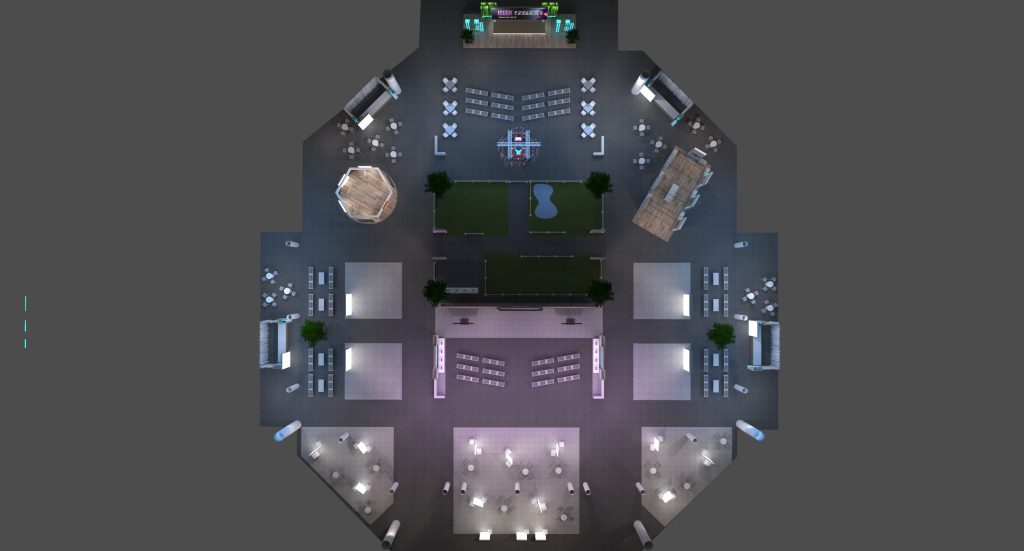

The project was developed using a mix of 3D models and video using real-time development platform Unity. Our in-house team designed, developed and built the AR experience at our offices in Nottingham. This work included both the front end app development that you see in the headset, as well as the backend work that stores the locations of the planted seeds so they can be shared across the AR headsets.
A sketch of the layout for the Augmented Reality exhibition space:
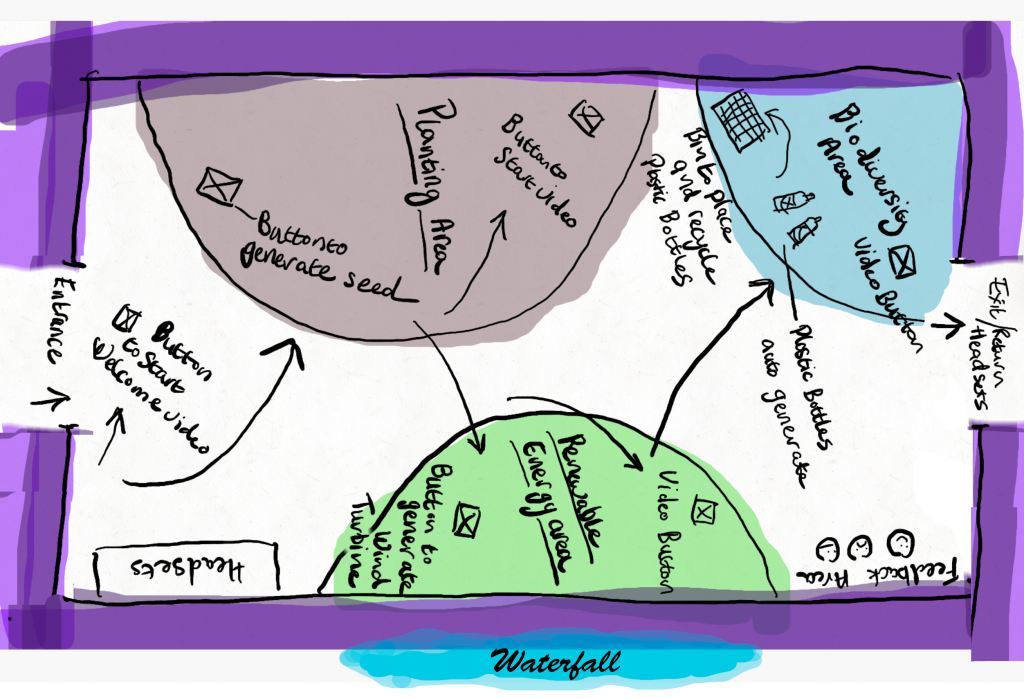
Design sheet for the ‘seed’ button:
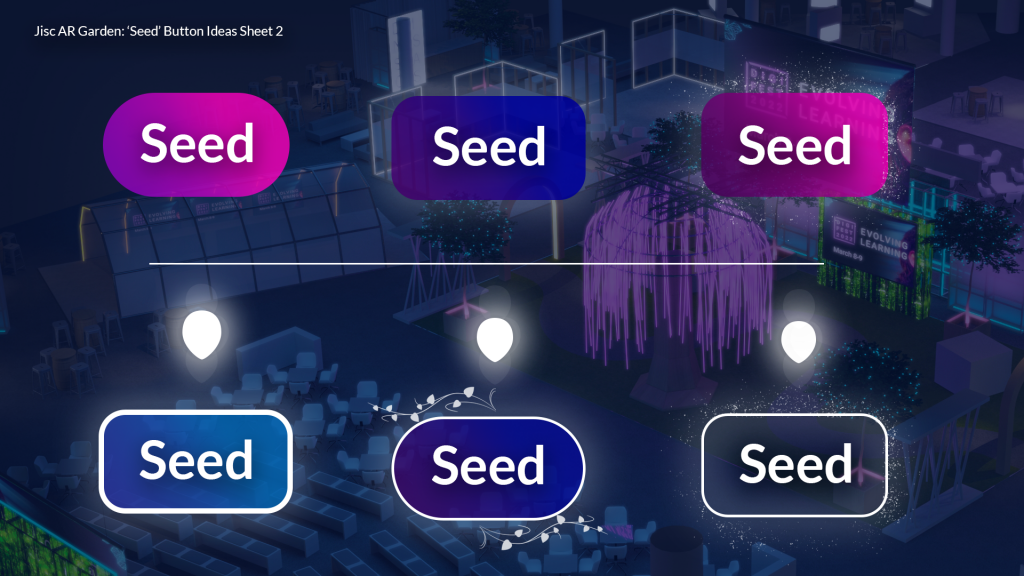
Using the HoloLens 2 headset to bring the exhibition to life
The HoloLens 2 projects holograms into real world space. This is very different from VR, where everything is in a digital space. The location can then be used to provide Mixed Reality environments. As the headset projects holograms, this is different to how people use the Meta Quest devices or Apple Vision Pro, which require the user to look through a screen or camera.
Headset networking using 5G
The headsets were networked using a 5G set up created by Cradlepoint. Using 5G enabled us to share the delegates’ experiences across the devices. This meant they could see the collaborative horticultural efforts of planting digital seeds in the garden, clearing the rock pool and starting the wind turbine.
We then ‘rebuilt’ the stand for Digifest at the ICC Birmingham. Therefore, when the stand builders were putting up their physical stands, we were there constructing a virtual exhibition space in what was the largest physical stand at the conference.
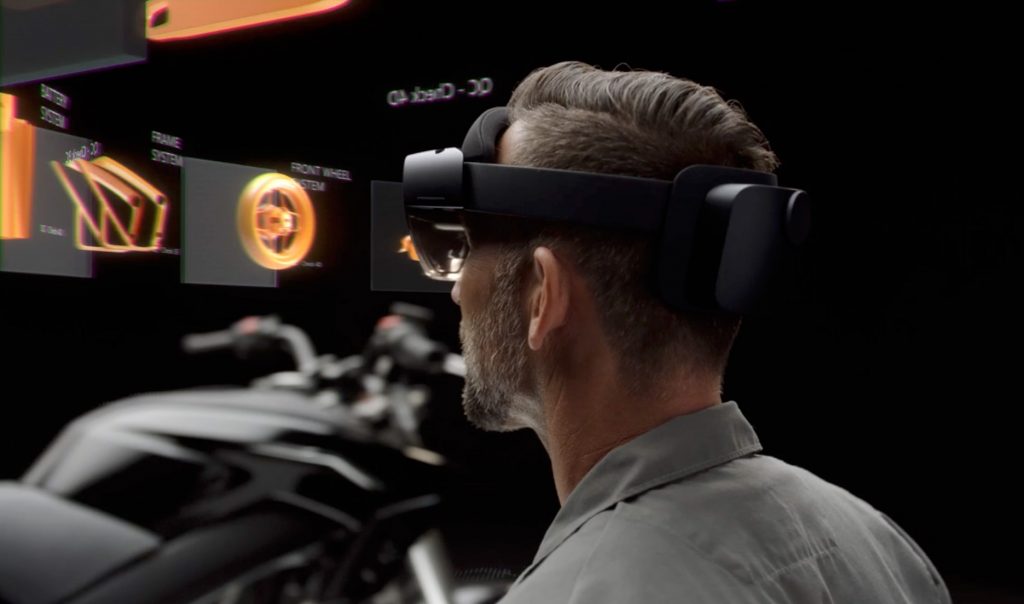
Benefits of using AR experiences for exhibitions
Augmented Reality exhibitions offer a dynamic way to engage visitors, amplify educational experiences and bring a new level of interactivity and excitement to the world of exhibitions.
Enhanced visitor engagement
AR exhibitions captivate visitors by providing interactive and immersive experiences. They enable you to fully immerse your visitor in your brand. This heightened engagement can lead to a more memorable, long-lasting and impactful visit. This is exactly why Augmented Reality is a brilliant technology to use for the leisure and tourism industries.
Create new digital activities that aren’t limited to physical space
AR can transform a physical space by adding digital layers that blend seamlessly with the environment, creating a surreal and visually stunning experience. AR exhibitions allow us to do things that aren’t normally possible with a physical stand. These include planting, speeding up time, creating water areas, having wildlife and adding a large, loud wind turbine.
Limited cost or complex logistics
Virtual exhibitions can be created without the cost or complex logistics associated with most exhibition stands. Not only would it be almost impossible to create the (e)co garden physically, it would require a huge budget to do so. With AR we make dreams a reality at a fraction of the cost.
Adaptable content that can be reset
For the (e)co garden, we created shared experiences that could easily be reset. Using AR to display the information allowed us to create dynamic and easily updatable content. Exhibitions can be adjusted, expanded or modified without the need for physical changes, keeping the content fresh and relevant.
Sustainability
There is less waste at the end of a virtual exhibition, as the majority of the stand is digitaland, and any physical structures used as part of the garden were hired in and either returned to storage or were to be re-used after the event. There is also no requirement for storage, other than on a server, and the stand can be rebuilt in new locations.
Augmented Reality gamification
AR ‘gamification’ marketing combines games and gaming elements with AR to bring fun to non-gaming contexts. It is designed to attract, engage and retain customers. It increases engagement rates by motivating visitors to achieve a goal or complete a task. Visitors are encouraged to actively participate rather than passively observe. Interactive elements, challenges and quizzes make the experience more engaging and educational.
Storytelling
AR can bring narratives to life through animations, re-enactments and visualisations, making the exhibition more captivating. We can also capture digital actors who are always on time, are never sick and always deliver the perfect performance.
Using AR to transform education technology
Augmented Reality has the potential to revolutionise education technology by enhancing traditional learning methods and creating immersive and interactive learning experiences.
In contrast to conventional learning approaches, the use of VR and AR technology to build training environments brings about better user engagement, immersion, enthusiasm and safety for learners. Pupils have the opportunity to explore the interior of an ancient pyramid or receive training in operating intricate machinery or medical apparatus. The range of potential real-world applications is vast and diverse. Using AR we are able to deliver AI educational experiences and demonstrate the educational establishments of the future.
How we used AR headsets for Jisc’s other educational projects
Magic Leap Augmented Reality headset:
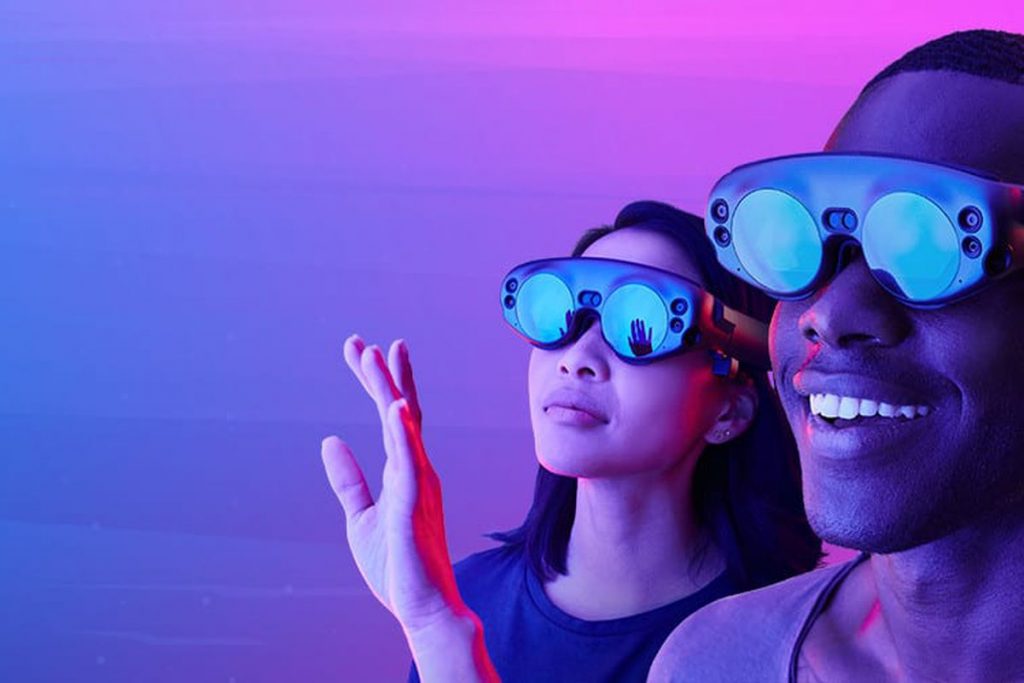
As part of Jisc’s VR and AR supplier framework, in 2020 we also developed content for the ‘Magic Leap Augmented Reality Headset’. It looks like a VR headset, but you can use it to interact with 3D figures projected in front of you. This headset maps your room like The Matrix so that it understands the structure of the room, enabling you to interact with it. This creates a platform for projecting anything you want before your very eyes.
As part of this initiative, we also worked with Jisc on its Education 4.0 project. We developed an AR student dashboard, featuring Nigel the AI chatbot, a fully immersive experience from the perspective of a history and geography undergraduate of the future.
Here’s an example of what the student experience could look like:
We then created the interface for the headset, enabling users to communicate with holograms of their tutors (a bit like wearing Iron Man’s helmet). It also enables students to check their heart rate, watch video messages and check the weather. Utilising the power of AR, our weather app simulated the real-world weather, so if it was raining outside, we made it rain in AR. We also incorporated a wellbeing app, including calming sounds and projections of clouds to help regulate breathing.
How to use AR exhibitions in your industry – bring your brand to life
The events industry is becoming more and more competitive, so exhibitors need to stand out from the crowd. Creative Augmented Reality exhibitions create eye-catching and memorable experiences and are designed for a variety of different industries. Think about how you can build an immersive experience around your customers’ wants, needs or problems.
In-store marketing and advertising AR experiences can enable virtual product or service demonstrations and create a pipeline of new leads of people who have virtually tested it. Manufacturers can transform expensive large-scale exhibitions into interactive and full-scale product demos.
It also enables you to demonstrate your business process, manufacturing line or customer journey. You can step away from the flowcharts and diagrams and create something that your customers can immerse themselves in.
Get in touch if you’d like to discuss how we could develop an Augmented Reality exhibition for your next event. Discover some of Gooii’s Augmented Reality projects.

